Accepted Scientific Name: Cocos nucifera L.
Sp. Pl. 1188. 1753 [1 May 1753] L.
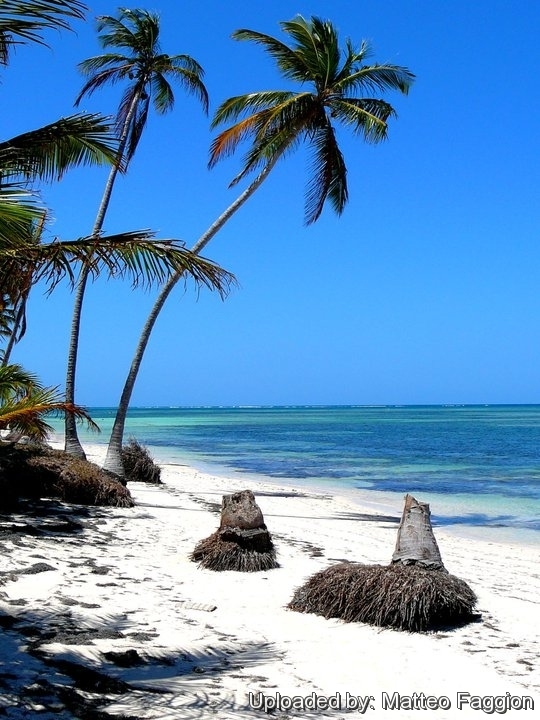
Palma cocos (Cocos nucifera) Photo by: Matteo Faggion
Growing habit at Punta Cana, Dominican Republic.
Origin and Habitat: Coconut is believed to have its origins in the Indo-Malayan region or the South Pacific, today it is grown both over the Asian continent (India, Ceylon, Indonesia) and in Central and South America (Mexico, Brazil)and in Africa, (Mozambique, Tanzania and Ghana).
Altitude: Usually less than 150 m, but will up to 600 near the equator.
Habitat: It is found in the narrow sandy coast along shorelines on sandy, saline soils, but it is now found on soils ranging from pure sand to clays and from moderately acidic to alkaline. Annual rainfall 1500–2500 mm.
Ecology: This tree has been spread largely by man, but also by natural means. The fruits can float for long distances and are often carried by ocean waves and currents from one island to another and still germinate to form new trees after being washed ashore.
Synonyms:
See all synonyms of Cocos nucifera
back
Accepted name in llifle Database:Cocos nucifera L.Sp. Pl. 1188. 1753 [1 May 1753]Synonymy: 7
back
Common Names include:
ENGLISH: Copra (product), Coconut palm, Coconut, Bahia coconut palm
ALBANIAN (Shqip): Arra e kokosit
ARABIC ( لعربية ): جوز الهند
ARMENIAN (Հայերեն): Հընդկական Ընկոյզ
ASSAMESE (অসমীযা়): Narikol
AZERBAIJAN ( Azərbaycanca): Kokos palması
BANJAR (Bahasa Banjar): Niur, Nyiur
BASQUE (Euskara): Kokondoa, Kokondo
BELARUSIAN (Беларуская): Какосавая пальма, Пальма какосавая
BENGALI (বাংলা): নারিকেল
BISLAMA (Bichelamar): Kokonas
BULGARIAN (Български): Кокосова палма, Кокос
BURMESE: Ungbin, Mak un on
CANTONESE (粵語): 椰, 椰子
CATALAN (Català): Nou de coco (fruit), Coco (fruit), Palma indiana, Palma cocotera, Coco, Cocoter
CENTRAL BIKOL (Bikol Central): Niyog
CHINESE (中文): 椰
CREOLE: Kokoye
CROATIAN (Hrvatski): Kokosova palma
CZECH (Čeština): Kokosovník ořechoplodý, Kokosový ořech, Kokos
DANISH (Dansk): Kokospalmen, Kokospalme, Kokosnoed, Kokosnød
DUTCH (Nederlands): Klapperboom, Kokospalm, Kokosnoot, Kokos
ESPERANT (Esperanto): Kokoso
ESTONIAN (Eesti): Harilik kookospalm, Kookospalm
FIJIAN (Na Vosa Vakaviti): Niu
FINNISH (Suomi): Kookospalmu, Kookospähkinä
FRENCH (Français): Coprah (product), Cocotier
GALICIAN (Galego): Coco
GERMAN (Deutsch): Kokosnusspalme, Kokospalme, Kokosnuss, Kokosnuß, Kokos
GREEK (Ελληνικά): Καρύδες, Καρύδα, Κοκκοφοίνικα
GUARANI (Avañe’ẽ): Mbokaja'a
GUJARATI (ગુજરાતી): શ્રીફળ, ગુજરાતી
HAKKA (Hak-kâ-fa / 客家話): Yâ-è
HEBREW (עברית): קוֹקוּס
HINDI ( हिन्दी): नारियल
HUNGARIAN (Magyar): Kókuszdió, Kókoshneta
IDO: Kokoso
INDONESIAN (Bahasa Indonesia): Kelapa
ITALIAN (Italiano): Palma da Cocco, Palma del cocco, Noce di cocco, Cocco
JAPANESE (日本語): ココナッツ
JAVANESE (Basa Jawa): Kelapa, Krambil
KANNADA (ಕನ್ನಡ): ತೆಂಗಿನಕಾಯಿ, ನಾರಿಕೇಳ
KAPAMPAGAN (Kapampangan): Buku
KASHMIRI: نارجیٖل
KHMER or CAMBODIAN: Doung
KOREAN (한국어): 코코넛
KURDISH (كوردی / Kurdî): گوێزی ھیندی
LAK (Лакку): Гьиндусттан гьивxь
LAOTIAN (ພາສາລາວ): Kok mak phao
LATIN (Latina): Cocos nucifera
LATVIAN (Latviešu): Kokospalma
LINGALA (Lingála): Kokotí
LITHUANIAN (Lietuvių): Riešutinė kokospalmė
MALAY (بهاس ملاي /Bahasa Melayu ): Pokok Kelapa, Nyior, Kelapa
MALAYALAM (മലയാളം): തെങ്ങ്
MALDIVIAN: ކުރުނބ
MANX (Gaelg/Gailck): Cro bainney
MARATHI (मराठी): नारळ
MIN NAN (Bân-lâm-gú): Iâ-á
MONGOL (Монгол ): Далдуу мод
NAVAJO (Diné Bizaad): Mágí bichʼiyąʼ
NEPALESE (Nepal bhasa नेपाल भाषा): नरिवल
NORTH FRISIAN (Frasch/Fresk/Nordfriisk): Kokospualem
NORWEGIAN (Bokmål): Kokosnøtt
ORIYA (ଓଡି଼ଆ): ନଡ଼ିଆ
PERSIAN (فارسی): نارگیل
POLISH ( Polski): Palma kokosowa, Kokos właściwy
PORTUGUESE (Português): Noz de coco, Coqueiro da Bahia (Brazil), Coqueiro, Coco da India, Coco da Bahia, Coco, Cairo (coconut fiber)
PUNJABI Shahmukhi script ( پنجابی ): ਨਾਰੀਅਲ
QUECHUA (Runasimi / Qhichwa simi): Pikwayu
ROMANIAN (Română): Cocotierului, Nucă de cocos (fructul), Cocotier
RUSSIAN (Русский): Кокосовая пальма
SANSKRIT (संस्कृतम्): केरवृक्, नारीकेल
SERBIAN (Српски / Srpski): Кокосова палма
SINHALESE: Polgaha
SLOVAK (Slovenčina): Kokosová palma, Kokosovník orechoplodový, Palma kokosová, Kokosovník obyčajný, Kokosovník
SLOVENIAN (Slovenščina): Kokosova palma
SPANISH (Español): Palmera de coco, Palma de coco, Nuez de coco, Cocotero, Coco
SUNDANESE (Basa Sunda): Kalapa
SWAHILI ( Kiswahili): Mnazi mti, Mnazi
SWEDISH (Svenska): Kokospalm, Kokosnöt, Kokos
TAGALOG: Ubod (palm heart), Niyog, Buko, Boko
TAMIL (தமிழ்): தெங்கு, தேங்காய்
TELUGU (తెలుగు): నారికేళము, కొబ్బరి
THAI (ภาษาไทย): มะพร้าว
TIBETAN (བོད་ཡིག་): བེ་ཏ།
TOK PISIN: Kokonas
TONGAN (Faka-Tonga): Niu
TURKISH (Türkçe): Hindistan cevizi
UKRAINIAN (Українська): Кокосова пальмаì
UPPER SORBIAN (Hornjoserbsce): Kokosowa palma
VIETNAMESE (Tiếng Việt): Dừa
WARAY-WARAY (Winaray): Lubí
WESTERN PUNJABI: ناريال
YIDDISH (ײִדיש / מאַמע לשון ): קאקאס
Description: The coconut palm is a slender single feathery palm 20-30 m tall, that, more than any other palm is a symbol of warm, sunny tropics. Not a tropical landscape can not be without the coconut palm. While this palm is highly valued as an ornamental, it is perhaps the widest-grown palm in the world. The coconut palm is a long-lived plant that may live as long as 100 years;
Trunk: The stem of mature specimen (40 or more years old) typically are 20–22 m tall, but tall varieties may attain a height of 24-31 m while dwarf varieties are shorter in stature . The trunk is slender and often swollen at the base. The trunk is typically curved or leaning, its bark is smooth and grey, marked by ringed scars left by fallen leafbases.
Canopy: Diameter of 8–9 m.
Leaves: 4 to 6 m long, pinnate (feather-shaped) and 1.2 m wide. Leaflets are linear-lanceolate, more or less recurved, rigid, bright green. The petiole (leaf stalk) is 0,9-1,5 m in length and spineless.
Flowers/inflorescences: The inflorescences (unbranched spadices), arising at leaf axils and are enveloped by a carinate spathe; Male and female flowers are borne on the same inflorescence, female flowers are borne basally, male flowers at apex. Male flowers are small, light yellow, bear lanceolate petals and 6 stamens. Female flowers are larger light yellow with an ovary consisting of 3 connate carpels. Cross pollination, either anemophilous or entomophilous, occurs.
Blooming period: Coconut palms begin to flower at about 4 - 6 years of age.
Fruit: Ovoid, green or yellow at first, turning brownish as it matures. up to 38 cm long and 30 cm wide and 1-2 kg in weight, is a drupe with a thin, smooth, grey-brownish epicarp, a fibrous, 4-8 cm thick, mesocarp and a woody endocarp (the shell of the seed).
Seed (or nut): The nut is 15 - 20 cm in diameter and 25 - 30 cm long. Inside the shell there is the “endosperm” which is partly liquid (coconut milk), and partly solid (flesh) which is a white, layer, about 2 cm thick at maturity. This layer is also known as the "meat" or copra and is very rich in reserve substances. The meat is soft and jelly-like when immature, but it becomes firm at maturity. At one end of the nut there are 3 sunken holes (a.k.a. germinating pore) of softer tissue called "eyes". When the embryo germinates, its radicle breaks through one of the three holes.
Bibliography: Major references and further lectures
1) Forest & Kim Starr Cocos nucifera (Coconut palm, niu). Plants of Hawaii. <http://www.starrenvironmental.com>. Downloaded on 21 August 2014.
2) Werth, E. “Distribution, Origin and Cultivation of the Coconut Palm.” Ber. Deutschen Bot. Ges., vol 51, pp. 301–304. 1933
3) Henderson, Andrew; Gloria Galeano; Rodrigo Bernal. “Field Guide to the Palms of the Americas.” Princeton, New Jersey: Princeton University Press 1995
4) Don Ellison, Anthony Ellison “Cultivated Palms Of The World” UNSW Press, 01/mag/2001
5) Robert Lee Riffle, Paul Craft “An Encyclopedia of Cultivated Palms” Timber Press, Portland 2007
6) John Dransfield, Natalie W. Uhl, Conny B. Asmussen, William J. Baker, Madeline M. Harley, Carl E. Lewis: “Genera Palmarum. The Evolution and Classification of Palms.” Royal Botanic Gardens, Kew 2008
7) Wikipedia contributors. "Cocos nucifera ." Wikipedia, The Free Encyclopedia. Wikipedia, The Free Encyclopedia, 6 May. 2014. Web. 25 Aug. 2014.
8) Michael J. Balick, Hans T. Beck “Useful Palms of the World: A Synoptic Bibliography” Columbia University Press 1990
9) M.M. Grandtner “Elsevier's Dictionary of Trees: Volume 1: North America” Volume 1 Elsevier, 08/Apr/2005
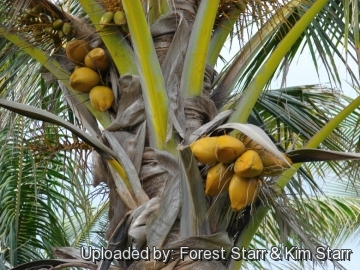 Coconuts at Kanaha Beach, Maui, Hawaii (USA). November 29, 2006. (Cocos nucifera) Photo by: Forest Starr & Kim Starr
Coconuts at Kanaha Beach, Maui, Hawaii (USA). November 29, 2006. (Cocos nucifera) Photo by: Forest Starr & Kim Starr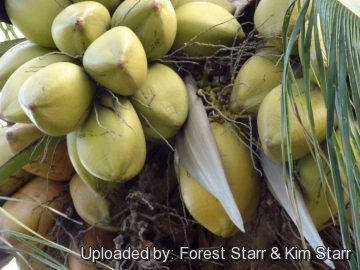 Coconuts at Maui Nui Botanical Garden, Maui, Hawaii (USA). November 06, 2006. (Cocos nucifera) Photo by: Forest Starr & Kim Starr
Coconuts at Maui Nui Botanical Garden, Maui, Hawaii (USA). November 06, 2006. (Cocos nucifera) Photo by: Forest Starr & Kim Starr Juvenile and mature specimens at Punta Cana, Dominican Republic. (Cocos nucifera) Photo by: Matteo Faggion
Juvenile and mature specimens at Punta Cana, Dominican Republic. (Cocos nucifera) Photo by: Matteo Faggion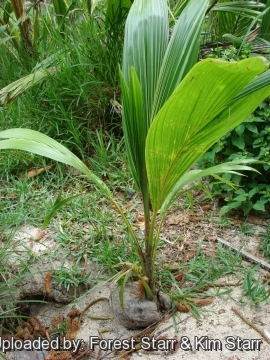 Seedling at Cable Company buildings Sand Island, Midway Atoll, Hawaii (USA). June 10, 2008. (Cocos nucifera) Photo by: Forest Starr & Kim Starr
Seedling at Cable Company buildings Sand Island, Midway Atoll, Hawaii (USA). June 10, 2008. (Cocos nucifera) Photo by: Forest Starr & Kim Starr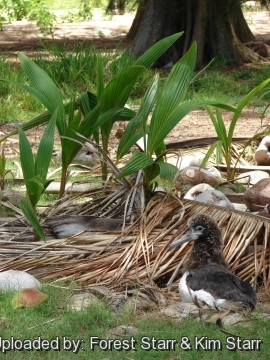 Habit with Laysan albatross (Phoebastria immutabilis) chick at Ave Maria Sand Island, Midway Atoll, Hawaii (USA). June 09, 2008. (Cocos nucifera) Photo by: Forest Starr & Kim Starr
Habit with Laysan albatross (Phoebastria immutabilis) chick at Ave Maria Sand Island, Midway Atoll, Hawaii (USA). June 09, 2008. (Cocos nucifera) Photo by: Forest Starr & Kim Starr Habitat and surfers at Hookipa, Maui, Hawaii (USA). October 17, 2006. (Cocos nucifera) Photo by: Forest Starr & Kim Starr
Habitat and surfers at Hookipa, Maui, Hawaii (USA). October 17, 2006. (Cocos nucifera) Photo by: Forest Starr & Kim Starr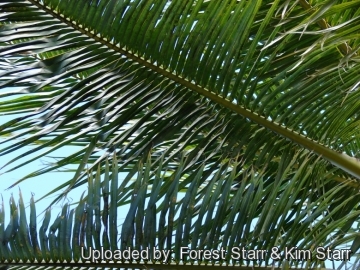 Leaves at Makawao, Maui, Hawaii (USA). December 31, 2006. (Cocos nucifera) Photo by: Forest Starr & Kim Starr
Leaves at Makawao, Maui, Hawaii (USA). December 31, 2006. (Cocos nucifera) Photo by: Forest Starr & Kim Starr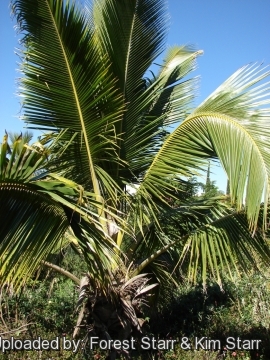 Dwarf habit at Enchanting Floral Gardens of Kula, Maui, Hawaii (USA). October 24, 2007. (Cocos nucifera) Photo by: Forest Starr & Kim Starr
Dwarf habit at Enchanting Floral Gardens of Kula, Maui, Hawaii (USA). October 24, 2007. (Cocos nucifera) Photo by: Forest Starr & Kim StarrCultivation and Propagation: It is an easy to grow palm that likes sandy soil, but is adaptable to clay and loam both slightly alkaline and acidic (from 5.0 - 8.0 ). It can tolerate brackish soils and salt spray. Good drainage is also important. The root system of this species is sensitive and good sized specimen is difficult to successfully dig and transplant to another location. Cocos palm vary in shape. Specimens raised in dry and/or infertile soils tend to be smaller in stature with smaller leaves. Light also affects the plant's form while those grown in full sun are more compact. Growth rate Moderate, 30–50 cm in height annually during the first 40 years of growth.
Fertilization: Need a perfect fertilizer diet including all micro nutrients and trace elements or slow release fertilizer. Micronutrient deficiencies are occasional problems. If it doesn't get enough Potassium (K), the leaves take on a necrotic spotting. Necrosis of the leaflet margins, followed by leaflet tip necrosis will also become apparent. Micronutrient deficiencies only show up on soil with a high pH.
Watering: It is quite drought tolerant, but enjoy rainy climates and proved to tolerate a wide variety of conditions. In areas where rains are abundant and regular, it seems to put on rapid growth with this ample water, but it does not want to sit in continually wet, mucky soil. It can tolerate waterlogged or flooded soil conditions for a few days. However, trees may decline and die when exposed to prolonged flooding or waterlogged soils.
Light: Prefers full sun but young specimen will tolerate half day sun. .
Hardiness: Coconut will be injured and may be killed by temperatures below 0 degrees C and may show chilling injury symptoms of leaflet necrosis at temperatures as high as 5 degrees C.
(USDA hardiness zones: 11-12). This palm is recommended for tropical climates.
Aerosol salt tolerance: It is very tolerant of saline water and soils, as well as salt spray.
Wind tolerance. It is very tolerant of wind and generally survive hurricane-force winds.
Maintenance: Prune diseased, damaged or drying fronds, but do not prune if the frond still has some green colour. Palms recycle nutrients from dead or dying fronds and use them for healthier fronds. Palms only have a set number of new leaves that can sprout and grow per year and removing fronds will not increase that number. If you cut off more than what will grow annually, you could be left with a pretty bare and bald Palm.
Propagation: Exclusively from seed – the coconuts, which are ready for planting if they produce an audible "sloshing" sound when shaken. The nuts are placed on their sides and buried with sand or mulch to about one-half the thickness of the nut. Germination is best under high temperatures (32-38 degrees C).
Uses: The coconut palm is perhaps the widest-grown palm in the world for its nuts. Coconuts are used as whole fruits or, conversely, by their parts: mesocarp fibres, milk, kernel (or flesh), husk. However, other parts of this plant are used too, notably its leaves to make baskets, roofing thatch etc., apical buds of adult plants are an excellent palm-cabbage, an alcoholic drink known as Toddy or palm wine is extracted from its sugar sap, tapped from the inflorescences by means of apposite cuttings.
Gardening: Either as a single specimen or in groups, this is a strikingly beautiful species. Its very neat appearance and stature makes it perfect near highways and used to accent residential landscapes. Culture in containers is possible although growth rates are slower. A bright patio will provide an excellent environment for young specimens which can eventually be planted in a sunny location. It is urban tolerant.
Warning: Falling coconuts can pose a serious (sometimes fatal!) health hazard to guests, they are often removed to avoid injuries and lawsuits.
Your Photos

by Forest Starr & Kim Starr

by Forest Starr & Kim Starr



















